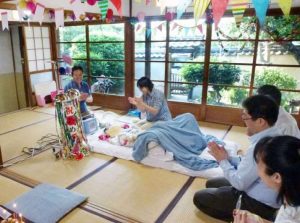
Matsukaze is a masterpiece of Japanese Noh theater, exploring emotional attachments to mortal desires; an examination of self-reflection on the nature of existence. Heady stuff, and common subject matter for Noh plays, which are a quintessentially Buddhist form of performance, manifesting philosophical and spiritual principles, couched in poetry, music, dance, and story. The play delves into themes of love, loss, and the ephemeral nature of life, drawing on Japanese literary traditions and Buddhist philosophy. Matzukaze is a representative work of art from Muromachi-era Japan (1336–1573).
In Matsukaze, impermanence, suffering, no-self, and cycles of spiritual existence are expressed as high art; a touching and sad story of two beautiful sisters who cannot release their passionate love for a lover who is not coming back. Matzukaze is a tale told under the umbrella of an early Japanese literary masterpiece, The Tale of Genji, written by the 11th-century author Murasaki Shikibu, and widely considered the world’s first novel. The influence of this new literature in Japan fueled an uplifting evolution of Noh into an art form replete with storytelling, poetry, and literary quality.

Matsukaze was created by Kan’ami, father of Noh’s founder, Zeami (Zay-AH-mee). Kan’ami had created a dance piece for the two sisters, who lived and worked collecting seawater for salt on Suma Bay. They return as ghosts, after dying on learning of the death of their courtier lover, Ariwara no Yukihira, for whom they waited day and night—longing, pining for the man who spent three years with them as an exile from the court. He left as suddenly as he came. The two sisters were desperately in love with him. In fact, their passionate attachments condemn them to an afterlife lost in the Wheel of Life and Death; an attachment so strong that they return as ghosts to relive their hopeless feelings at the very site where love was found. Zeami took his father’s dance piece and built a full play around it. The play would go on to become one of Japan’s most respected Noh plays. Zeami mentions this play more than any other in his writings, giving advice to actors.
In the play, a wandering priest notices a lonely and weatherbeaten but beautiful pine tree with a memorial plaque affixed. It tells of the two sisters, Matsukaze and Murasame, who died of grief and unrequited love. The priest says a prayer for them, and takes shelter in a fisherman’s hut occupied by two sisters. In the night, he learns who they really are: the ghosts of the two sisters from long ago. Lost in already transient emotions and swirling memories, they beg the priest for deliverance so they can be free to reach enlightenment and escape the Wheel of Life and Death. Along with the plaque on the pine tree is a poem by the poet and lover who abandoned them, the courtier, Yukihira:
In anyone chances
to ask after me,
tell them I live
alone, soaked
in the dripping seaweed
on the shores
of Suma Bay

When the priest reads this, it acts like a talisman to unleash the ghosts of the two sisters, who reveal their deep love and equally deep pain. Now ghosts, the futility of their behavior is tragic, but their emotional attachments have sealed their spiritual fate. As with this fleeting world, in its panoply of appearances and seductions, emotions have as little reality as a passing reflection of the moon.
In perhaps the most poignant section of the play, the two sisters re-enact, in a dance, the gathering of salt by taking up buckets of seawater. In a kind of madness, Matsukaze wears Yukihira’s robe and courtier’s hat. When she sees her reflection in the water . . . she see him. As they dip their buckets into the water, they see the reflections of the moon, and begin to chase it out, trying to capture the moon in their buckets rather than gathering salt. It becomes a metaphor for their spiritual plight: caught up in chasing the ephemeral reality of existence. It is terribly sad and evokes great compassion.
The name Matsukaze evokes imagery of the wind blowing through pine trees, a symbol associated with longevity and endurance in Japanese culture. Pines are known for their resilience and ability to withstand harsh conditions, making them a potent symbol of strength and perseverance. In the context of the play, Matsukaze’s name reflects her enduring love and longing for Ariwara no Yukihira, despite the passage of time and the trials she has faced. Like the wind in the pines, her emotions are constant and unwavering, even as she is haunted by memories of the past. The sound of wind through the pines is melancholic and haunting, subtle, then strong, mirroring Matsukaze’s sense of longing and sorrow. The play’s atmosphere is infused with this sense of melancholy, as Matsukaze grapples with the ephemeral nature of human emotions and passionate love.

The name Murasame, meanwhile, conjures images of gentle autumn rains, associated in poetry with sadness, nostalgia, and the passage of time. Autumn is a season of transition and change in Japanese culture, symbolizing the impermanence of life and the inevitability of decay. Murasame’s name reflects her role as the elder sister and her deep connection to the passage of time. Like autumn rains, her emotions are tinged with a sense of sadness and resignation as she reflects on the fleeting nature of human existence. Autumn rains are symbolic of renewal and rebirth, as they nourish the earth and prepare it for new growth. In the context of the play, Murasame’s presence represents the cyclical nature of life and the possibility of transformation, even in the face of loss and despair.
There are several translations of this profound Noh play. One notable example is by Donald Keene, in his Twenty Plays of the Noh Theater (Columbia University Press, 1970). It is not long, but deeply poetic, powerful, and moving. The closing lines, chanted by the chorus who speak for the sisters addressing the priest, linger in the mind:
In a dream of deluded passion,
Pray for us! Pray for our rest!Now we take our leave, the retreating waves
hiss far away, and a wind sweeps down
from the mountain to Suma Bay.
The cocks are crowing on the barrier road,
Your dream is over, Day has come.Last night you heard the autumn rain
This morning, all that is left
Is the wind in the pines,
The wind in the pines.
See more
Related features from BDG
The Ancient Noh Stages of Sado, the Isle of Exile
Noh Now
Pure Land Buddhism in Noh: The Shuramono Plays of Zeami
Beauty and Sadness: Reflections on a Japanese Noh Play












